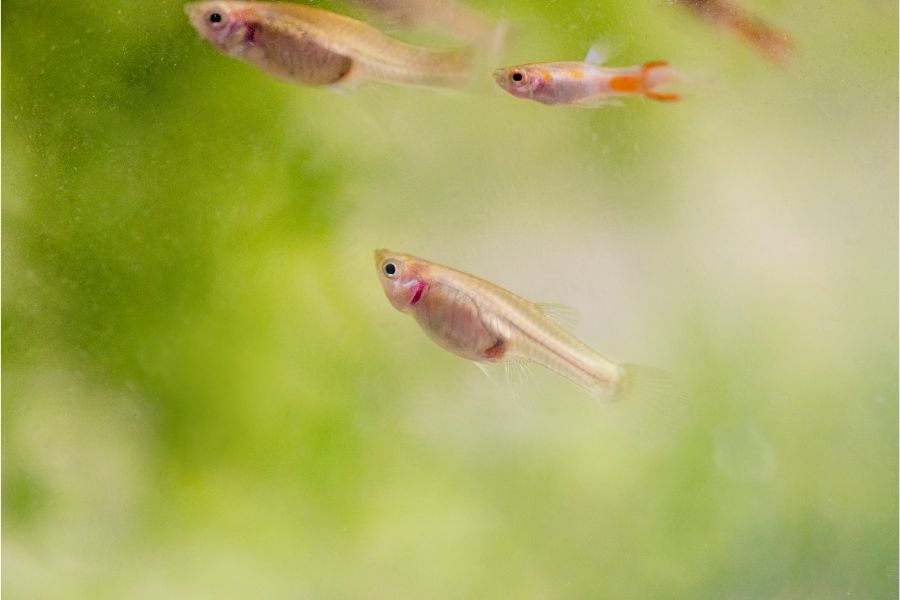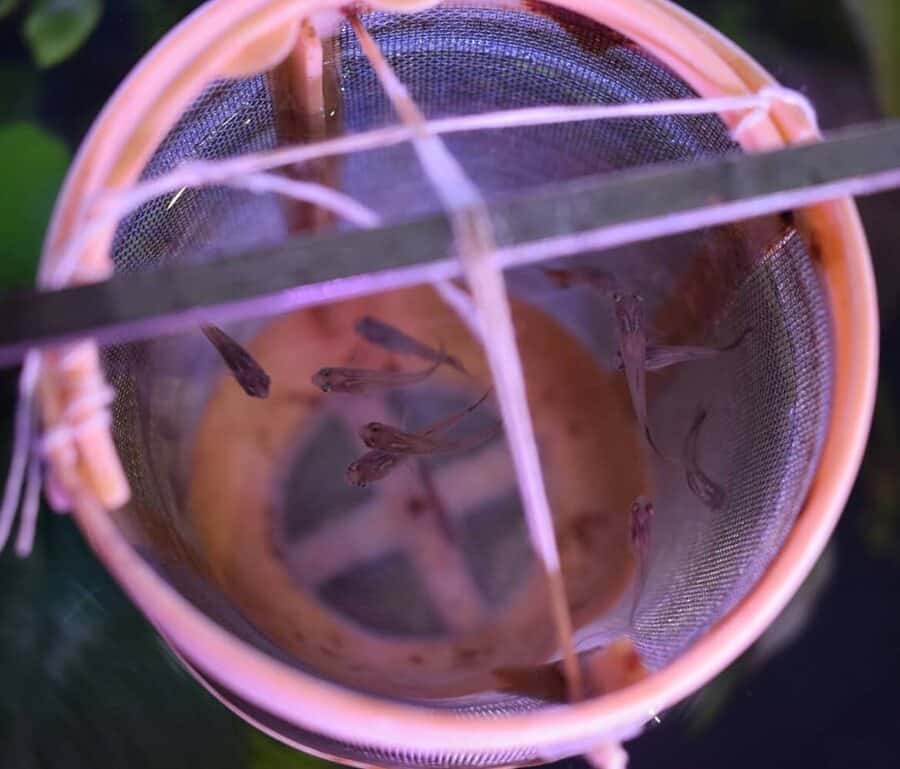Being tiny and hardy, keeping Guppies requires less maintenance and attention. Despite minimal care, they still multiply fast, earning their alternate name – the Millionfish.
While many of us are familiar with Guppies, we focused on their adult life, and only a few truly know about their juvenile stage.
Perhaps, you may ask the following questions: How do Guppies give birth? What do their babies look like? How do their parents treat their babies after birth? Do their babies need special care and maintenance?
Join us in this article as we answer all these questions in detail, and allow us to share our years of experience in handling the babies or fries (singular: fry) of this popular and colorful fish.
The Birth of Guppy Fries
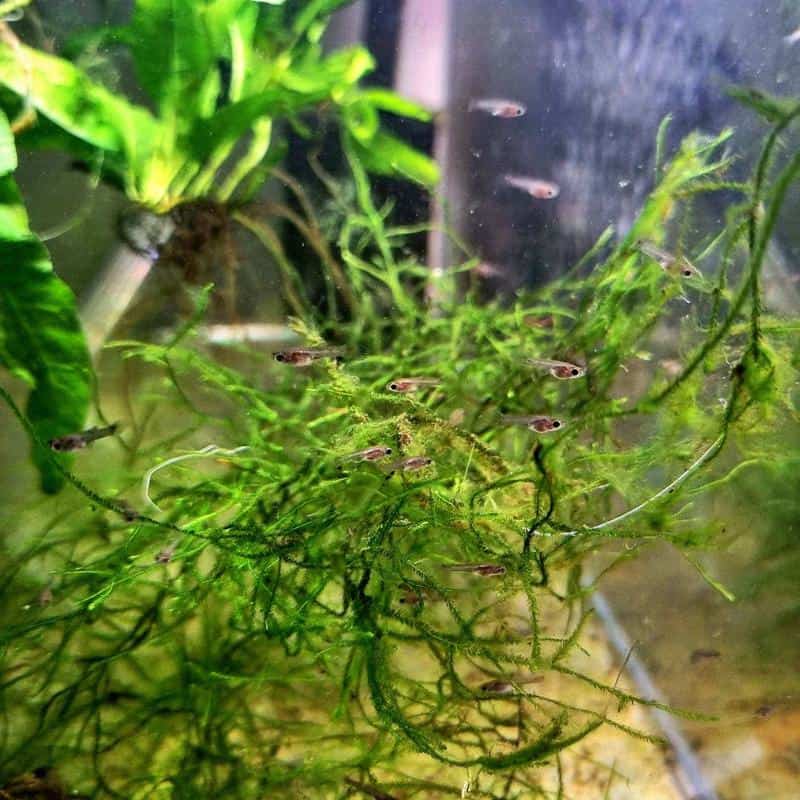
Guppies become sexually mature when they reach six months old. During courtship, males try to attract the attention of females by displaying their elaborate fins. Once paired, mating commences.
As females get pregnant, their stomach bulges, and their pregnancy can last anywhere from 21 to 30 days. In some types, like the transparent Glass Guppy, you can see the development of eggs inside their tummy.
When the females are about to give birth, they hide underneath the plants and sometimes become motionless. If you see these signs, be ready since this is the moment we have all been waiting for.
Ovoviviparous Delivery
Most aquarium fish reproduce their offspring by laying eggs that will hatch in a few days. However, this is not the case for Guppies.
Instead, Guppies are livebearers. When females are about to give birth, they push their tummies, forcing their fries to be released into the water and become free-living. Some of us may have seen how Guppies give birth, but only a few know how their eggs develop inside the womb.
Scientifically, Guppies are ovoviviparous. The eggs are developed and hatched inside the mother’s womb.
When a female Guppy reaches sexual maturity, it produces eggs and is fertilized internally by the males during mating. From fertilized eggs, it develops into an embryo, and its nourishment is directly provided by its yolk sac until they hatch into a fry.
Expect a Dozen Fries per Female
Depending on the species, each female can produce 20 to 200 eggs. However, not all will hatch into a fry.
Water conditions, genetics, health, and age of the pregnant female are some of the factors that can influence the hatching rate.
For a healthy pregnant female that is given proper care and kept in a well-maintained tank, you can expect a 50 to 90% hatching rate. Based on our experience, a single pregnancy in female Guppies produces 20 to 60 newly born fries.
Instant Swimmers
During delivery, the mother stays in midwater, and Guppy Fries are released one by one. When they are born, Guppy fries will swim instantly. In most cases, they go to the bottom right after birth and group themselves into a school.
At first, their school is inactive, and they prefer to stay in a shelter, like aquarium plants. Soon after, they will venture out to feed.
Monthly Birth
Do not be surprised if your female Guppy keeps getting pregnant and gives birth to new fries every month. It is a reproductive strategy of Guppies which increases their chances of passing on their genes.
Aside from this, be aware that Guppies are highly fertile. It means that they can produce a large number of fries over time. Based on our experience, our female Guppies keep producing healthy fries until they reach two years old.
Appearance of a Guppy Fry
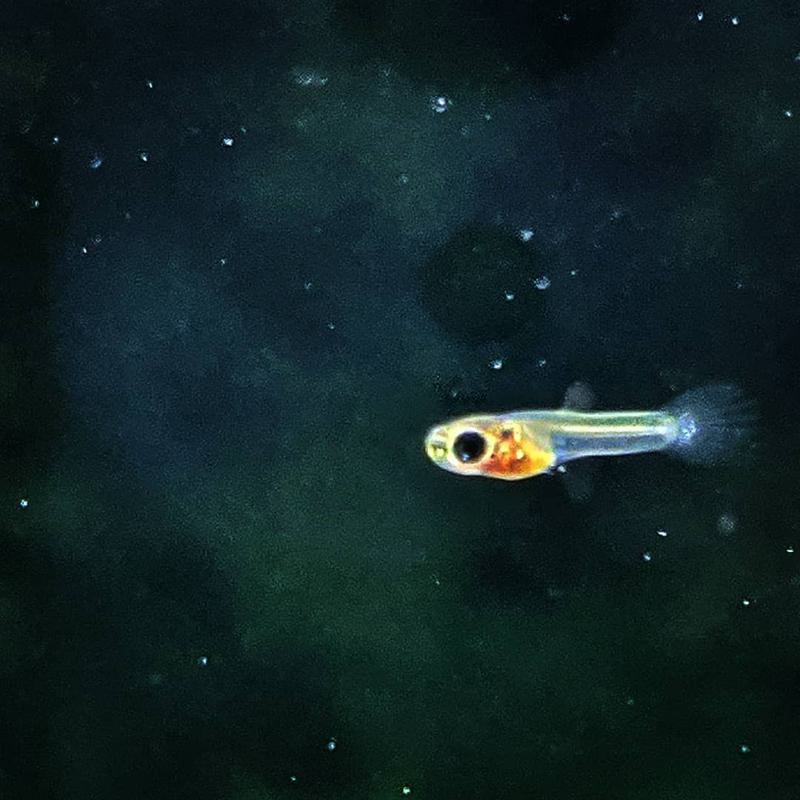
You may have seen a Guppy Fry, but describing them in detail would all boil down to their miniature size. Well, even if they are super tiny, there’s lots to know about Guppy fries.
Non-resemblant Offspring
When they are out, Guppy Fries do not fully resemble their parents. While their body parts continue to develop, they still lack coloration and pigment patterns.
Instead, Guppy Fries are generally translucent. During the first few days, their internal organs are visible (that’s if you have a 20/20 vision). In some species where its adults have elaborate coloration and markings, their fries may exhibit faint colors and light pigmentation.
A Quarter of an Inch
If adult Guppies are small, how much more for their fries. But how small? Do you have a guess?
Once they are out, Guppy Fries measures anywhere from 0.2 to 0.3 inches (0.5 to 0.8 cm) in length, averaging a quarter of an inch. Depending on the species, availability of food, and growing conditions, your Guppy Fry can grow to 0.4 to 0.6 inches (1 to 1.5 cm) in just a few weeks.
Growing Pigmentation and Color Pattern
As your Guppy Fries continue to grow and develop, color patterns and pigmentation will start appearing visibly.
Depending on the genetic makeup of their parents, Guppy Fries start to intensify their body color, spots or stripes become more evident, and body parts (especially the dorsal and caudal fin) will become more pronounced.
Resemblant Offspring in 2 months
Even if your Guppy Fry undergoes significant changes as they grow, they still don’t look like their parents. They only exhibit the traits of their parents when they reach two months old.
By this time, you can see their type of caudal fin, caudal fin pattern, body color, pattern, and pigmentation.
Predation after Birth
Being tiny, Guppy Fries makes a great and tasty food item for other aquarium fish. However, you don’t need other species of fish for your Guppy Fries to be preyed upon since their parents will become their very own predator.
Forced Parental Removal
One of the effects on female Guppies when they give birth to their fries is a decrease in appetite. However, this is only temporary. When they recover, they go back to their normal feeding behavior. But this time, it is different since their young presents as an easy meal for them.
But why? Aside from being an omnivore, there are hormonal changes in female Guppies after giving birth, and one of these is the increased production of cortisol that triggers cannibalism.
Moreover, parent Guppies do not take care of their young. Once the fries are out, they are on their own. All of these are some of the reasons why you should remove the parents after the fries are born.
Care and Maintenance of Guppy Fries
Although adult Guppies require less maintenance, you need to put some effort and some preparation into keeping up with the care and maintenance of Guppy Fries.
Pre-Birth
In terms of preparation, expecting to have Guppy Fries is like expecting a baby. But instead of buying new clothes, toys, and milk, it all boils down to the following:
Assign a Breeding Tank
Guppies are usually kept in a community aquarium or in a species-only tank. However, when you see the early signs of labor, you need to transfer the pregnant female to a separate breeding tank.
In this way, pregnant females will not be disturbed during labor. Further, when Guppy Fries are born, they will not be preyed upon by other fish.
Provide Hiding Places
During labor, pregnant females prefer to stay under the shade. Knowing this in advance, provide your breeding tank with shade using aquarium plants. If you want to level up their sense of security, you can use both bottom plants and floating plants.
Similarly, the plants that serve as shade for pregnant females will also become the hiding spots once Guppy Fries are born.
Post-Birth
Aside from removing their parents after delivery, taking care of Guppy Fries focuses on the following:
Feeding
Guppy Fries are not picky eaters. The fact is that they can eat any food their parents are consuming. Some of their favorite food items include flakes and live food like brine shrimp and daphnia.
Regardless of the type of food you give to your Guppy Fries, what is crucial is that it should be crushed (except for the live food). Remember that Guppy Fries are tiny, and this gives you an indication how miniature their mouth is.
You should also be aware of their appetite. Unlike the twice or thrice daily feeding in adults, Guppy Fries require multiple feeding everyday. The reason for this has something to do with their digestion where their entire ingestion cycle only takes 30 minutes to complete.
So after that, your Guppy Fries are hungry again. Yes, they are small, but their appetite is big and round the clock.
Favorable Water Conditions
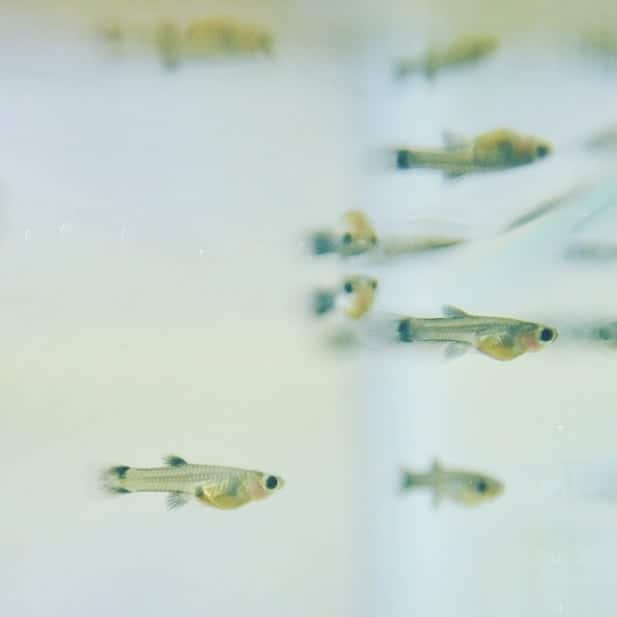
As long as the parents are comfortable with the water conditions, your Guppy Fries will also be satisfied. However, how do you make sure that your water parameters are conducive for Guppy Fry growth when you are removing their parents after birth?
First is keeping your water warm anywhere from 24 to 27 C (75 to 80). Some breeders slightly increase their temperature once in a while since it increases their metabolism. However, if you are not sure how to do this, please do NOT do it since it can lead to sudden temperature fluctuations which the Guppy Fries are sensitive to.
Although light is not a primary concern for fish since they are not photosynthetic, they play a vital role in Guppy Fry development.
In their case, light influences how their skeletal system is developed. When exposed to low or intense light, their normal growth pattern is affected, disrupting their skeletal development. In Guppy Fries, this equates to spinal deformities which is also linked to shortened or prolonged light exposure.
With this, only provide your Guppy Fries with moderate lighting and expose them anywhere from 12 to 16 hours a day. In this way, you are giving them 8 to 12 hours of rest and sleep every day.
Summary of Guppy Fry Growth Requirements:
| Parameters | Range |
| Temperature | 24 to 27 C (75 to 80 F) |
| Water flow | Low |
| pH | 6.0 – 7.0 |
| Hardness | 8 to 12 dGH |
| Light | Moderate for 12 hours |
Also Read:
FAQs
Do Newly Born Guppy Fry Still Have a Yolk Sac?
No. Newly born Guppy Fry does not have a visible yolk sac. Even if it provides them nutrition when they are still an embryo, the yolk sac is left behind when they hatch. Occasionally, some of the yolk sacs are expelled during birth together with the Guppy Fries. Leave the yolk sacs behind since they are an excellent source of protein when eaten by your Guppy Fries.
When Can I Determine the Gender of A Guppy Fry?
Determining the gender of a newly born Guppy is impossible. They need to grow and develop their distinctive gender traits which only becomes visible when they reach 3 to 4 months old.
Can Guppy Fries Survive in A Community Tank?
Yes. But the chances of growing up to an adult are slim as they are continuously preyed upon by other fish (not to mention their parents).
Can I Do a Water Change when There Are Guppy Fries?
Yes. Adding fresh water promotes the growth and development of Guppy Fries. Ideally, you can do a 25% water change every week.
What is crucial during water change is to keep the disturbance to a minimum. During water suction, place a fine mesh net at the suction tube so that Guppy Fries will not be sucked in. Similarly, when you pour in water, use a hose or pour it gently so as not to create strong water flow.
Final Thoughts
With 20 to 60 fries per month, it is no wonder why Guppies are called the Millionfish. And come to think of it, we are only speaking of one pregnant female. So, can you imagine if you have a school of adult female Guppies?
So, stop reading now, set up your Guppy tank, and prepare for the arrival of their babies (or should I say: your babies too).
Finally, before you stop reading, I just want you to know that my rare Albino Guppy just gave birth using all the techniques we have just described. And guess what, I’m planning to sell them soon, which you can also do as a business.
